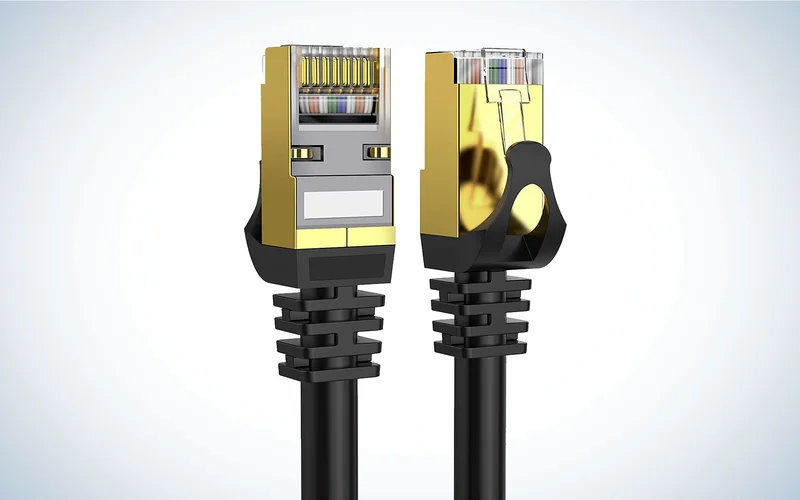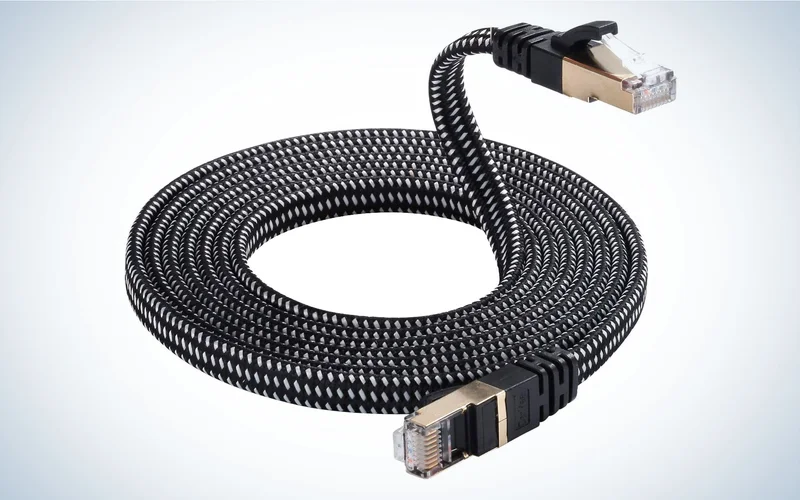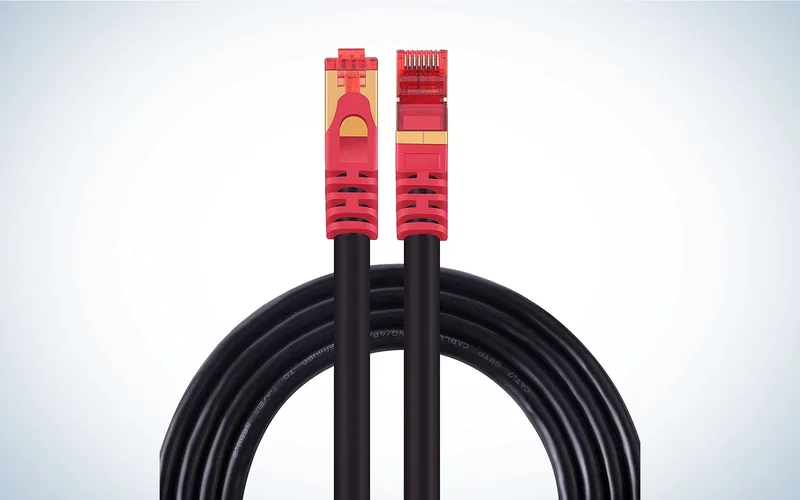Introduction
Over the last several years, the online gaming industry has exploded in growth, and we are seeing the emergence of an increasing number of brilliant gamers along with it. To win online games, you need to have some talent. Even if you have the fastest WiFi router, you probably aren’t getting the most out of your online games if you play them over a wireless connection. Therefore you will need a suitable ethernet cable to get unlimited fun. To find out what is the best ethernet cable for gaming, continue reading!
Best Ethernet Cables for Gaming
List and Table of Specifications
| Name | Standard | Frequency | Speed | Length | Shielding |
|---|---|---|---|---|---|
| Dacrown Cat8 | Cat8 | 2000 MHz | 40 Gbps | 5-150 ft | S/FTP |
| Danyee Cat7 Braided | Cat7 | 600 MHz | 10 Gbps | 1.6-100 ft | STP |
| Jadaol Cat7 | Cat7 | 600 MHz | 10 Gbps | 25-100 ft | STP |
| Shinekee Outdoor Cat7 | Cat7 | 600 MHz | 10 Gbps | 25-200 ft | STP |
| Amazon Basics Cat6 | Cat6 | 250 MHz | 1 Gbps | 3-50 ft | UTP |
Dacrown Cat8

When talking about the best ethernet cable for gaming, how can you ignore cat8. The highest standard currently available, Cat8, will naturally catch your attention if you’re looking for the finest Ethernet cable for gaming. Cat8 cables come from various manufacturers, but we discovered that Dacrown consistently outperformed the competition in ratings from both users and reviewers for providing reliable, high-speed internet at a reasonably affordable price. Although there is considerable discussion among users as to whether the majority of consumer-grade Cat8 cable is “genuine” Cat8, capable of supporting the format’s full capacity, users of Dacrown cables often express satisfaction with the way they work. For the foreseeable future, Dacrown’s Cat8 Ethernet cable will provide a quick and stable connection for gaming.
Pros
- very rapid throughput
- long-lasting PVC weatherproofing
- extensive selection of lengths
Cons
- The only con is that it is slightly expensive.
Danyee Cat7 Braided

Almost all Ethernet cables have a simple, monochrome plastic coating. That’s OK if you can covertly run them out of sight, but it otherwise highlights the visual ache that results from improperly maintained cabling. While many companies provide coloured plastic, Danyee goes above and above with their line of high-quality nylon-braided Cat7 cables, which come in four distinct designs and hues. This braided Ethernet cable is the ideal for gaming because it is flat, which is useful if you need to run it under carpet or through a door, and because the nylon weave covering increases friction to prevent slippage. One minor drawback is that the cable is stiffer and more difficult to handle since it is coated with both nylon and PVC. Rare complaints of the nylon unravelling due to heavy handling also exist.
Pros
- fantastic data speed
- Numerous choices for fashionable nylon braiding
Cons
- Rigid
- Nylon could tear
Jadaol Cat7

Although flat cables are often necessary for running Ethernet cables through walls or other confined locations, circular Ethernet cables are the norm. The finest flat Ethernet cable for gaming is made by Jadaol and comes in a variety of standards. These cables are strong and very flexible, making it as simple as possible to run them around corners and into confined places without putting any pressure on the internal wires. This is made even easier by the provided nail-in clips, which make it fast and simple to tuck the cable neatly up against the baseboard, behind a door frame, etc. It could be challenging to get the precise length you want with just 25, 50, and 100 feet choices available, particularly for short runs. However, if you want a high-speed solution that can be tucked under furniture and beneath carpets, these are the cables you want.
Pros
- Fantastic data speed
- Flat
Cons
- Comprised clips
- Lack of possibilities for length
Shinekee Outdoor Cat7

It is definitely worth investing a little bit extra to acquire an outdoor cable that is engineered to withstand the environment when you need to run your Ethernet outside. The internals of Shinekee’s outdoor cable, which are shielded, twisted pairs of copper cable and gold connectors, are just as high-quality as those of the other cables on our list, but it also has an extra-durable PVC coating that is resistant to UV rays and water, and is suitable for being buried underground. It’s also the longest cable on our list, with a 200-foot option, and should continue to operate at full Cat7 speed at that distance.
Pros
- Fantastic data speed
- A robust PVC covering
- Suitable for usage both outdoor and underground
Con
Slightly expensive
Amazon Basics Cat6

For Amazon Basics, Ethernet wires fall just at the sweet place. It is simple for Amazon to take advantage of its enormous size with low-cost equipment since it is a frequently utilised commodity with no brand loyalty. Cat6 Ethernet cable from Amazon Basics is hard to match if all you need is consistent gigabit internet at the lowest price available. You won’t use it for large projects since it only extends to 50 feet, but there are more possibilities at the short-run cables than at any other brand on our list.
Pros
- Trustworthy gigabit performance
- Good selection of sizes
- Good value
Cons
- Just Cat6
- 50 feet maximum
Things to think about when purchasing a best Ethernet cable for gaming
When attempting to compare Ethernet cables, it is quite simple to get annoyed. Labels and product listings are difficult to grasp because of the peculiar and perplexing standard for differentiating cables. Here’s a quick guide on how to pick excellent Ethernet cables from defective ones, regardless of whether you want to use them for gaming.
Choose your cable according to your internet speed
When you are buying the best ethernet cable for gaming, keep in mind that your internet connection uses the Ethernet wire just as a conduit or tube. Your connection can only go as fast as the maximum internet speed allowed by your data plan, which is expressed in megabytes (or increasingly gigabytes) per second. More sophisticated lines handling 10+ Gbps will overkill if your ISP restricts you to 50 Mbps.
On the other hand, if you have a high-speed plan and pay for it, you should ensure that you aren’t restricting it by utilizing a poor cable.
Plan your work, then carry it out
The quality of your service is directly impacted by the length of Ethernet cables. A cable connects a source and a receiver, and the longer the connection is, the more the signal will deteriorate, slowing down your internet. To reduce the amount of cable you need to connect your modem, router, and other devices you want to use with wired internet should all be located as near as possible.
Before configuring a device with an Ethernet connection, plan out your configuration and decide how to route your connections to make it as efficient (and unnoticeable) as feasible. Measure the distance the cable will need to go after you know where everything will be, and then get a cable that is as near to that length as you can (while still giving yourself a little slack to Work with). Since Ethernet cables are relatively inexpensive, there isn’t much of a price difference between the most and least costly cable lengths. If you’re not attempting to wire a whole home, it’s simple to justify a little investment on a completely future-proof cable.
Herding Cats
Categorization, short for a category, is the primary method used to identify Ethernet cables.
The numbered categories—from Cat1 to the most current Cat8—refer to several standards generations developed by the Institute of Electric and Electronic Engineers (IEEE). This technical cooperative establishes independent standards for many areas of technology. According to IEEE regulations, each category is guaranteed to see a significant increase in data transmission speed and efficiency while maintaining a set of high requirements for quality, such as backward compatibility with previous cables.
As fast and reliable internet is necessary for gaming, which tops our list of the best Ethernet cables, we advise you to opt for Cat7 or Cat8 cable, with Cat6 acting as a backup for those on a tight budget. Gigabit-plus internet is supported by all three levels, providing you complete access to a fast connection. Cat5 is still used rather often, but the price difference is so little that you may as well have six at least.
250MHz is the maximum frequency that Cat6 supports, translating to 1 Gbps over 100 meters of cable and 10 Gbps over 55 meters of cable. Cat7 operates at 600MHz, which corresponds to 10 Gbps over up to 100 meters of cable if you want to reach the moon.
Additionally, compared to lesser classifications, it is more robust and has less signal distortion. The most recent top standard, Cat8, leaps up to 2GHz, allowing it to easily accommodate 10 Gbps over 100 meters of cable or crazy rates of 25 or even 40 Gbps up to 30 meters.
For my 1 Gbps home network, 40 Gbps looks like great overkill, and you’d be correct if you thought that. Cat8 is mainly intended for business applications for technology sector applications like data centers, much as Cat6 was when it was initially launched in the early 2000s.
However, more recent Cats are also required to meet stricter building regulations that reduce noise and lengthen longevity. Consider investing more money on superior, longer-lasting cable if you’re purchasing a lot of Ethernet wire to run through the walls of your house. Cat8 is accessible to the typical consumer and is often promoted as state-of-the-art in-home networking, even though it is mainly designed for enterprises.
Twisted pairings, foiling, and shielding
Through the use of “twisted pairs,” which aren’t just the performative emo couple from your high school but refer to tangled wires that, through the magic of electromagnetics, somehow reduce noise, all cables Cat6 and up are shielded from internal “crosstalk” (interference generated by other wires within the cable).
Twisted pairs are only the foundation for shielding in contemporary Ethernet cables. When choosing your cable, you should be aware of the many cable types available. UTP cables, often known as “unshielded twisted pair,” provide the minimum level of security since they just twist. STP cables, also known as “shielded twisted pair,” improve that security by enclosing all of the twisted pairs in a layer of shielding to reduce outside interference. Each twisted pair in FTP cables, also known as “foil twisted pair,” is surrounded by a layer of protective foil. For the best possible defense against crosstalk and electromagnetic interference, S/FTP cables combine the inner and outer shielding of FTP and STP cables.
Shielding is a need for both Cat7 and Cat8; thus, upgrading has an additional benefit. Cat6 must have UTP, however certain cables provide extra security. Cat5 are like the wild west: either they have it or they don’t. In any case, it’s important to verify the degree of safety your cables provide.
These are some of the most important things to consider, which you should never overlook when you are buying the best ethernet cable for gaming.
Wrap Up
Hopefully, this has cleared up any ambiguity you may have had about the factors you should take into account when choosing the finest Ethernet cables for your gaming experience. Wireless is acceptable for the majority of applications, but the speed and reliability of a cable connection will truly benefit your PC, Xbox, or PS5. Cat7 and Cat8 cables are a simple method to update and future-proof your system since they are reasonably priced and presently provide significantly faster internet than most ISPs now offer in most regions.
Read more blogs on technaldo.
FAQs
When compared to Wi-Fi, is Ethernet faster?
Yes. Wi-Fi has advanced to the point where you can stream videos and do most internet surfing without needing to plug in, but gaming’s added requirements truly show the difference between wired and wireless connections.
Does Cat7 outpace Cat6 in speed?
Each generation or “category” of Ethernet cable, as we previously said, is quicker than the one before it. An internet connection of 10 Gbps may be supported using Cat7. Cat6 has a 1 Gbps connection limit. Along with having higher raw speed than Cat6, Cat7 also has extra shielding, which may enhance signal quality.
Having said that, Cat7 connections are only quicker than Cat6 cables if your internet service plan can support a connection speed of more than 1 Gbps. The wires will seem to be virtually similar to many people.
Are Cat8 cables worth the expense?
One the one hand, very few consumers will be able to fully appreciate the differences between Cat8 and earlier standards since 40 Gbps is far more throughput than most consumer data plans provide. However, the total cost of Ethernet cable is so cheap, particularly over short distances, that you would only need to pay a little premium to completely future-proof your home network. You should be able to more than satisfy your demands without breaking the budget since Ethernet connections can already carry far more than the majority of home users need.

